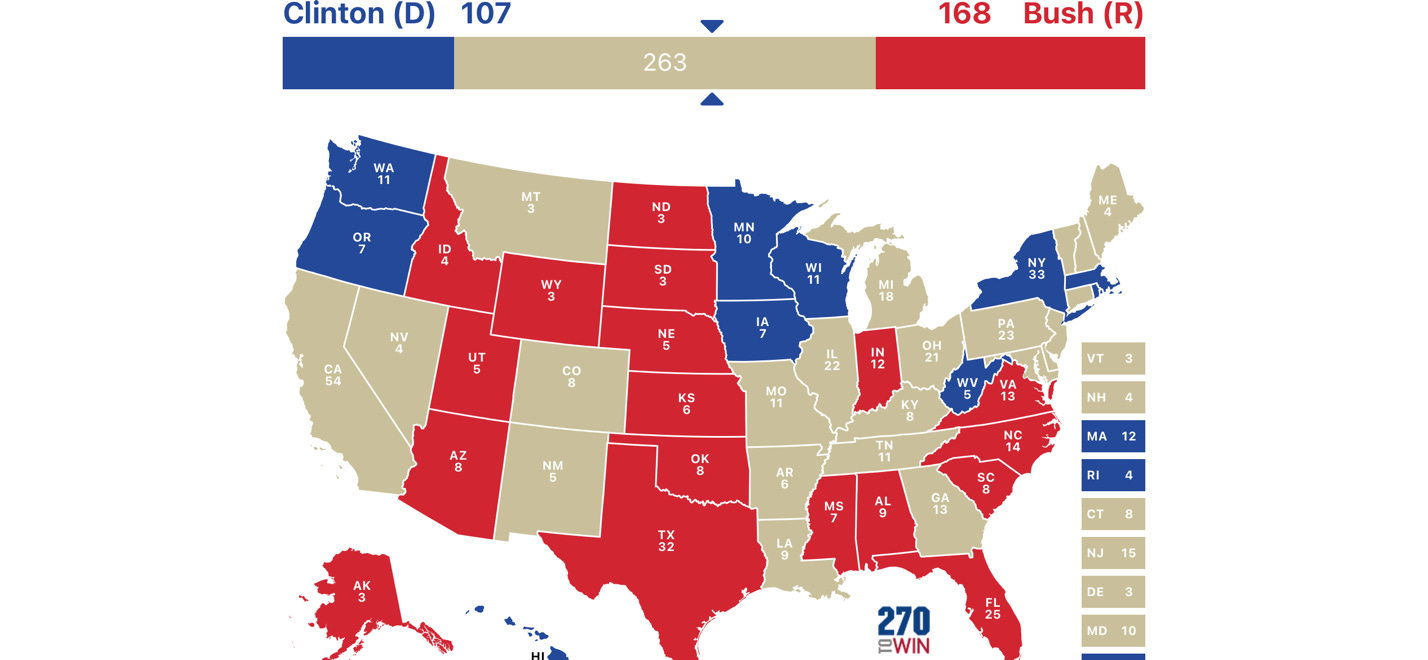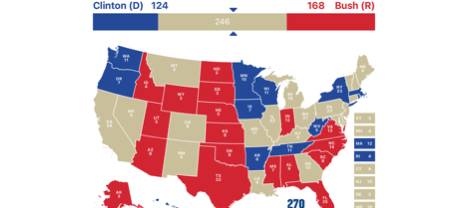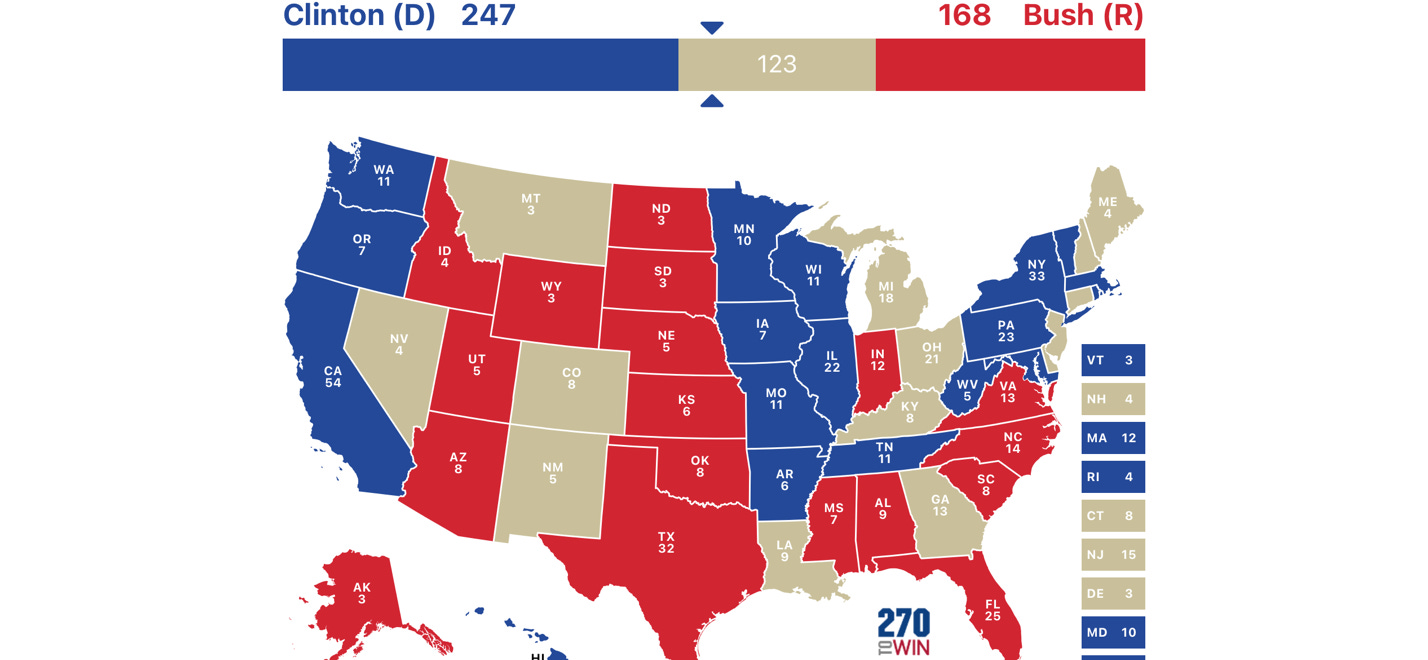Even without the squeeze of a recession and the famous flub that started out, “read my lips…” George H.W. Bush faced a difficult reelection campaign in 1992; in fact, Reagan and Bush had already won three consecutive presidential terms for the Republican Party, marking the only such occurrence since the end of World War II (Roosevelt and Truman had been the last, and they won five consecutive terms together). Bush teetered to the GOP nomination with a share of just 72.8% in the party primary, a soft number weakened by Pat Buchanan’s challenge from the right.
Furthermore, the national popular vote margin had shifted from more than 18 points in favor of President Reagan’s reelection in 1984, to less than 8 points in favor of Bush in 1988, although the latter performance still produced a national landslide worth 426 electoral votes. The political pendulum eventually swings, and the longer that swing takes, the more dramatic the impact is.
While the Clintonian White House denotes the starting point for many of modern America’s serious issues, the late business tycoon and Texas billionaire H. Ross Perot is often scapegoated for allowing William Jefferson Clinton, the 42nd President of the United States, into 1600 Pennsylvania Avenue. But was it really Perot’s fault that Bush lost his re-election campaign?
I have analyzed four elections from 1984 through 1996 and have determined that Bush would have lost reelection to Clinton even without Perot on the ticket.
Buckle up.
The 1988 Dukakis electoral slate, of which all states except Minnesota flipped from Reagan to Dukakis, all had a heavy Democrat trend, as did many states President Bush barely held on to in 1988, like Illinois.
These were all on a leftward trend with the Republican incumbent seeking a fourth consecutive party term and are no-doubters for Clinton in 1992. The only states in this group to provide Republican electors after the 1992 election are Iowa (three times), West Virginia (six times), and Wisconsin (once officially); the rest belong to the “blue wall.”
1988 Dukakis states + DC (electoral votes in parenthesis)
Hawaii (4)
Iowa (7)
Massachusetts (12)
Minnesota (the only “blue” state from 1984) (10)
New York (33)
Oregon (7)
Rhode Island (4)
Washington (11)
Washington, D.C. (3)
West Virginia (5)
Wisconsin (11)
Running Clinton Total – 107 electoral votes (163 more needed to win)
-
Bush dropped the following 22 states from his quiver of four years prior (an asterisk denotes a state that joined the “blue wall” and has never since produced Republican electors, with Maine’s 2nd Congressional District not included):
Arkansas, California*, Colorado, Connecticut*, Delaware*, Georgia, Illinois*, Kentucky, Louisiana, Maine*, Maryland*, Michigan, Missouri, Montana, Nevada, New Hampshire, New Jersey*, New Mexico, Ohio, Pennsylvania, Tennessee, Vermont*
Here is the breakdown of these 22 states:
Two states, Arkansas and Tennessee, went to Bush in 1988 by margins that resemble Reagan’s from 1984; they did not weaken substantially as most of the country did in their Republican support. Clinton, the sitting governor of Arkansas, carried his home state handily with a majority (53.2%), which happened to be the only state he won with over 50.0%. Tennessee, the home state of his running mate, Senator Al Gore (who managed to lose it to Bush in 2000 while running for President), appears to pay the same honor to the top of the ticket, and backed Clinton-Gore four years later for re-election.
Clinton Wins Due to Nuance (electoral votes in parenthesis)
Arkansas (6)
Tennessee (11)
Running Clinton Total – 124 electoral votes (146 more needed to win)
-
Seven states were on a heavy Democrat trend after Reagan’s re-election and went to Bush in 1988 by less than five points each, with Illinois, Pennsylvania, and Maryland all finishing within three points. That national environment moved over 10 points to the left from the 1984 landslide, and these states that barely held on in the Bush column appear destined to align with Clinton in 1992. Four of the six had a Democrat lean in 1996, as well, confirming the lunge leftward.
Clinton Wins of Heavily-Democrat Trending 1988 Bush State (electoral votes in parenthesis)
California (54) – 12.6% Democrat trend in 1988
Illinois (22) – 10.8% Democrat trend in 1988
Maryland (10) – 2.6% Democrat trend in 1988, Clinton near a majority
Missouri (11) – 16.0% Democrat trend in 1988
Pennsylvania (23) – 5.0% Democrat trend in 1988, Bush losing much of Reagan’s coalition
Vermont (3) – 13.6% Democrat trend in 1988
Running Clinton Total – 247 electoral votes (23 more need to win)
-
With Clinton clearly within striking distance, needing two big states to get him over the line, or a combination of smaller states, let’s look at which states I think were Peroted (should have gone to Bush in a two-man race).
States that Likely Would Have Gone to Bush in 1992 Without Perot Candidacy (electoral votes in parenthesis)
Keep reading with a 7-day free trial
Subscribe to Captain K's Corner to keep reading this post and get 7 days of free access to the full post archives.






